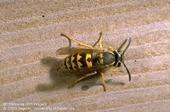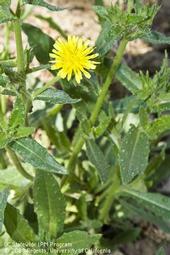- Author: Belinda J. Messenger-Sikes
- Author: Karey Windbiel-Rojas

We all have our favorite products, whether it's laundry detergent, shampoo, or a pesticide you know works against the pests in your home or garden. But what happens when a company changes the ingredients in a product? Does it work, smell, or lather differently?
You may visit a store looking for a pesticide product by name, not realizing that several popular pesticide brands have recently changed their active ingredients (the materials in pesticide products that actually...

Yellowjackets have a well-deserved reputation for being aggressive since they often sting when defending their nests or when they encounter people while out scavenging for food.
This time of year, yellowjacket colony populations are increasing, and people may encounter them more frequently. Some yellowjacket species live in underground nests and can be a problem to people mowing the lawn or to children playing on it. Other kinds of yellowjackets may live in between voids in walls and ceilings of houses, coming into contact with people who pass by.
Sometimes paper wasps are mistaken for yellowjackets, but these insects are much less aggressive and more easily dealt with.
If you have a wasp...

[From the Summer issue of the UC IPM Retail Nursery & Garden Center News]
When you use firewood in the great outdoors, be aware that moving firewood can transport tree-killing insects and diseases. Find out more at the following resources:
- “Don't Move Firewood,” a campaign created by the Nature Conservancy, is an informational site aimed at the general public. You can also print posters, brochures, and other handouts.
- The California Firewood Task...

This summer, you may have noticed what looks like a large dandelion plant covered in blisters growing in your lawn or landscape. It's known as bristly oxtongue, and if you examine or touch it you'll see and feel why. The stems and flower bracts are bristly, and the leaves are covered with blisterlike swellings that are prickly to the touch.
Bristly oxtongue can be an annual weed or a biennial weed. It thrives during the winter and warm weather and can grow to be over 3 feet tall. This weed spreads by seed, which can be dispersed long distances by the wind.
According to the book, Pests of the Garden and Small Farm, you can control bristly...

Saturday, August 18 is National Honey Bee Day! Many people are concerned about the health of honey bees, and rightly so, as there has been a decline in their populations during the last decade.
This year on National Honey Bee Day, learn how you can protect honey bees by choosing plants for your landscape that bees prefer visiting to collect pollen and by avoiding the use of pesticides that can be toxic to bees.
For specific details about what else you can do, read the article What Can Gardeners do to Help Honey Bees.
Resources
Bee...


